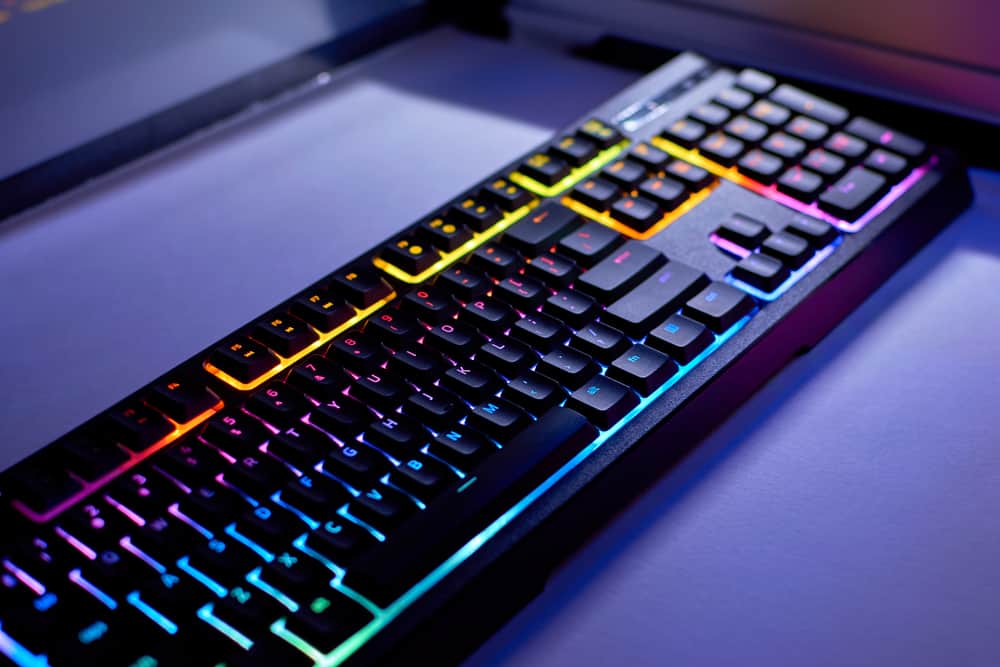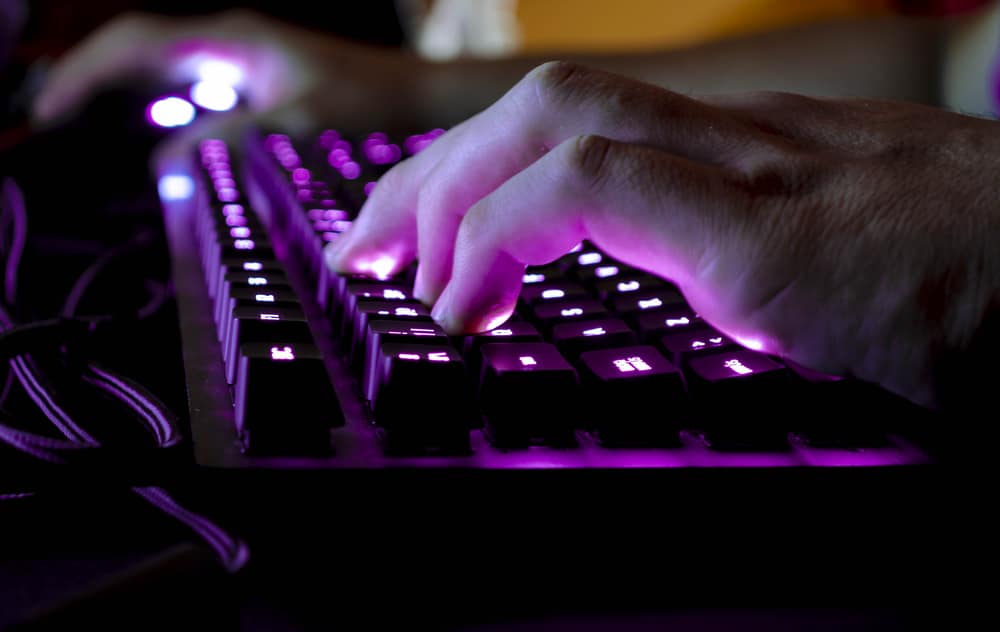
Modifying your keycaps is a great way to add variety and give your keyboard a cool new look.
You just need to find your perfect keycaps and swap them.
However, it’s important to know whether you should get customized keycaps or if they’re universal.
Are Keycaps Universal?

Keycaps aren’t universal because keyboards come in different sizes, profiles, designs, and shapes.
The keyboard’s size determines each key’s size and the space in which the keys are arranged.
Stems and stabilizers are other key factors that determine the shape and size of keycaps.
However, you can still find keycaps for your keyboard if they’re broken or if you want to customize your keyboard.
Some aftermarket keycaps match several keyboard designs with standard key profiles and sizes.
What Makes Keyboards And Keycaps Unique?

Manufacturers compete to offer the most unique and ergonomic keyboards to stand out and offer the best user experience.
In addition, they have aesthetic features in mind that make the keycaps unique.
Here are the primary factors that make keycaps not universal:
1. Keycap Profiles

Keycap profiles determine the aesthetics and ergonomics of the keyboard by arranging the keycaps in certain shapes and heights.
When you look at the keyboard sideways, you can notice a specific pattern in which the keycaps are arranged.
Some keyboards have a flat design, while others have sculpted formats to give them a unique look and feel.
Sculpted profiles involve each row with different designs and heights to let the user feel and recognize keys more comfortably.
These designs have a special arrangement of flat, angled, rounded, or concave keycaps to create an overall shape that feels most comfortable for your fingers while typing.
Keycaps profile also affects its thickness, which is its height and can be high, middle, and low.
Based on these overall shapes, you can find five keycap profiles in the market.
A. SA
SA (Spherical All) keycaps are high profile, with the tall keys allowing for more sculpted possibilities.
While the earlier designs were uniform, modern SA keycaps come in semi-cylindrical shapes.
The concave design on each key creates a pleasant resting place for fingers and gives your keyboard a vintage look.
B. OEM
Most modern keyboards have OEM (Original Equipment Manufacturer) profiles featuring angled keycaps and a sculpted shape that make them ideal for most typing tasks.
Many manufacturers offer their stock keyboards with OEM keycaps, making it the most common profile.
The keys are about 12mm tall, with the front side of the keys taller than the back side, giving them an angled top.
However, the sculpted design isn’t as noticeable as the SA profile.
In addition, since it’s mass-produced and used by many manufacturers, such as Razer, Corsair, and Logitech, it’s considered a standard profile.
C. Cherry
The Cherry profile is the most similar to OEM, with sculpted but shorter keycaps.
The only difference between Cherry and OEM profiles is that the former has a less subtle sculpting, giving it a more ergonomic design.
It’s also popular and perfect for gamers and those who want efficiency and productivity.
D. Flat
You can see flat keycaps mostly on laptop keyboards.
They have a flat, unsculpted surface, giving a uniform texture to the entire keyboard.
These are perfect for those who want a creative design for their keyboards, as they offer various customizability options.
One of the most common types of flat, uniform profiles is the DSA profile, which has 7.6mm-tall keycaps.
However, it’s not as flat as laptop keycaps as it has a concave top but a uniform shape.
E. Other Keycap Profiles
In addition to the most common keycaps mentioned above, you can find other profiles on specific keyboard models.
They may not be as common as the above profiles, making finding replacement keycaps more challenging.
XDA. Medium profile, spherical or flat, uniform.
KAT. High profile, angled, sculpted, concave.
KAM. Uniform, short, concave.
G20. Low profile, uniform, angled.
MT3. Sculpted, angled, concave.
DOM. Look like snow globes, high profile, rounded, uniform.
Tai-Hao. Very high profile, sculpted, concave.
Chiclet. Uniform, very low profile, mostly used on laptops.
MBK. Uniform, extremely low profile.
NP. Medium profile, spherical, flat, uniform.
DSS. Low profile, rounded top, sculpted.
2. Keyboard Layout

Another essential feature that makes keycaps unique is how the keys are arranged on the keyboard, aka its layout.
The way the keys sit next to each other on the keyboard can affect other characteristics that may vary among other layouts.
The most common layouts designed by two standard institutes are ANSI (American standard) and ISO (European standard).
Although they may look similar at first glance, they have essential differences.
For example, the Enter key on the ANSI layout is rectangular, whereas it’s an upside-down L on the ISO.
The left shift key is also different, with ANSI having both shift keys the same size and shape.
However, on ISO, the left shift key is smaller than the right one.
There are other layouts in terms of the placement of alphabetical keys.
QWERTY, QWERTZ, and AZERTY are among the most common types that show the placement of these letters on the first row.
3. Stems And Stabilizers

The keycaps on your keyboard are simply tools that allow you to interact with your computer and register when you hit them.
The part that is connected to your computer’s brain and does the behind-the-scenes job is the switch.
Stems are small plastic connections that join the keycap to the switch.
These stems are essential in keycap design because keyboards have different keycap stem shapes.
The keycap has a female connection that locks into the switches’ male connection.
If they’re not the same shape, they don’t fit.
The most common stem shape is the “+” design, but many manufacturers have unique stems that don’t fit into other types.
However, this shouldn’t be an issue since most manufacturers follow the Cherry MX style, which is the “+” stem.
Larger keys have an extra attachment that makes them stay in place and function properly.
Called a stabilizer, this attachment comes in different shapes depending on the manufacturer.
The most common types are Costar and Cherry.
You should check before purchasing new keycaps.
4. Keyboard Size

Not all keyboards are the same size. Some are standard while others are compact.
Sometimes, manufacturers add fancy keys to their keyboards, changing the layout and size.
Here are the sizes that keyboards typically come in:
- Full size
- Compact
- 96%
- Tenkeyless
- 75%
- 65%
- 60%
- 40%
If the keyboard is not full-sized, you may have some keys left out.
For example, you may have the number pad, the function row, or the arrow cluster removed in some of the above designs.
Keyboard size also affects the space between the keys—a feature that is also determined by the layout and profile.
If you have a standard-size keyboard, there’s a higher chance of getting compatible keycaps, but with non-standard keyboards, it gets tricky.
5. Keyboard Type

Keyboards are peripherals that manufacturers use to show their creativity and offer greater comfort and productivity.
As a result, you can get different designs that fit specific purposes.
For example, backlit keyboards have become widely popular, especially among gamers.
If your keyboard has a backlight, your choice of aftermarket keycaps is limited to backlight-compatible types.
Ergonomic, split, Macropod, or Ortho keyboards have unique designs that dictate different keycap shapes, layouts, and sizes.
6. Keycap Sizes

If you look closely at your keyboard, you’ll notice that not all the keys are the same size.
When shopping for replacement keycaps, you should know the size of each row’s keycaps expressed in u, which stands for units.
The standard keycap is square and 18mm by 18mm in dimension.
This is the 1u standard that most keycaps follow.
You may find 1.25u for letter keys and 1.5u, 1.75u, 2u, and 2.25u for modifier keys.
The standard size for the space key is 6.25u, but it may vary depending on the keyboard size and design.
7. Keycap Materials

Keycaps are usually made of two plastic types, ABS, which is more common, and PBT, mostly used on KAT and MT3 keycaps.
If you plan on changing your keycaps, you should know your current and new keycaps’ materials.
While different materials shouldn’t raise any compatibility issues, you should know each material’s characteristics.
For example, ABS has a crisper sound, comes in more colors, and gives you more robust keys.
On the other hand, PBT keycaps don’t become shiny with prolonged use, produce a deeper sound, and are rougher to the touch.
How To Change Keycaps

If you decide to give your keyboard a cooler look, you can order compatible keycaps from different online shops after considering the abovementioned criteria.
Most keycap kits come with removal clips that help you take out the keys more easily.
The tool locks into either side of the keycap after you pull it down with a clicking sound.
Apply gentle force to remove the keycap without scratching it.
If there’s dirt and grime on the keyboard, clean it with a damp microfiber cloth and place the new keycap.
Compare the keycaps to make sure the new one is the same size as the original keycap.
After fitting the stems, apply a little pressure until the keycap falls into place.
Do the same for the other keys.
NEXT: How Big Is A 27-Inch Monitor? (Explained)

























